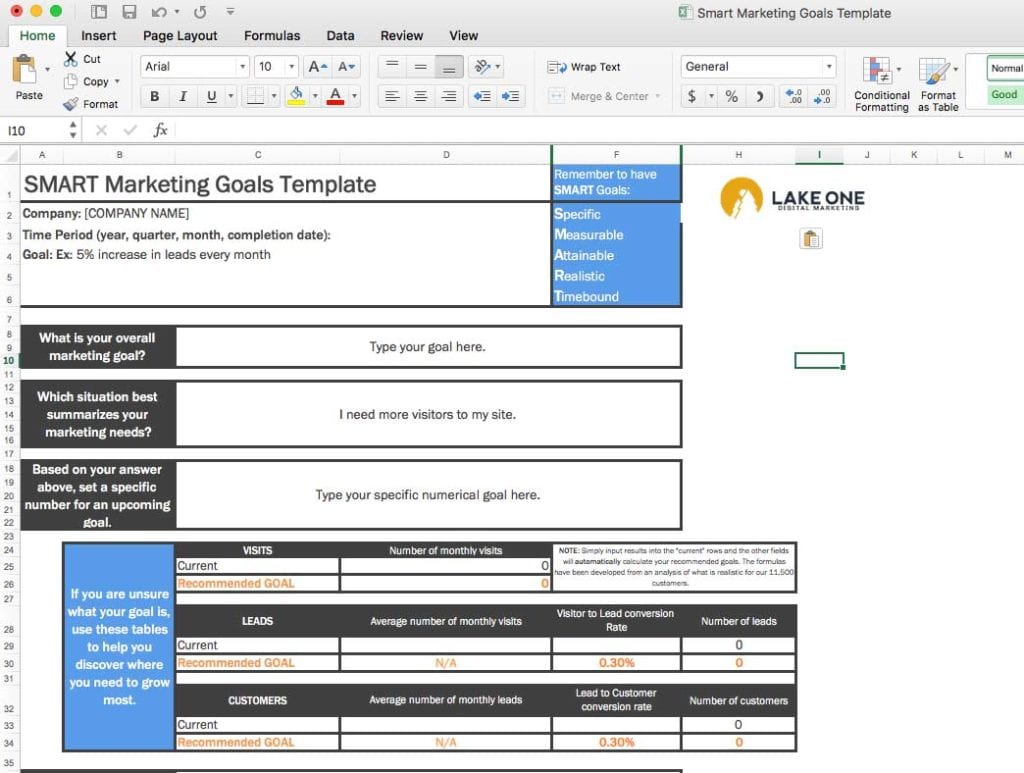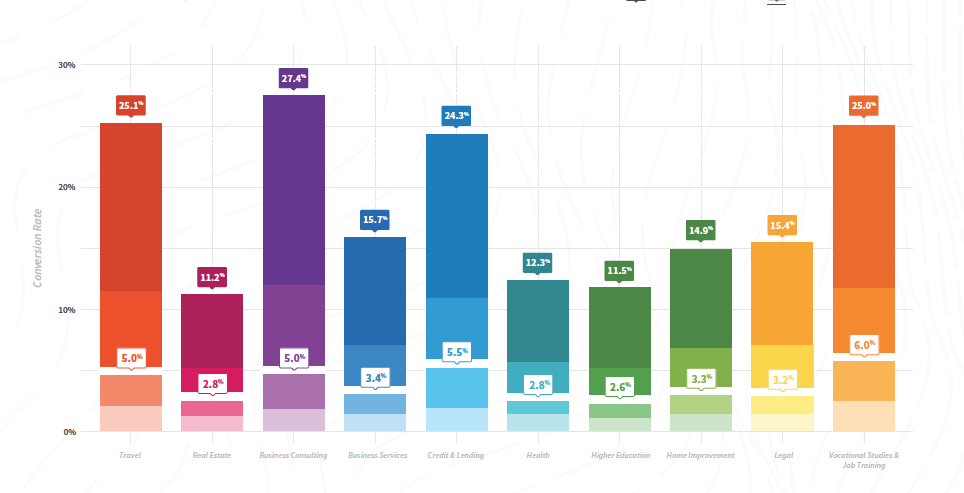Goal setting. The words either strike terror into every fiber of your being, or you tingle with excitement. All drama aside, like it or love it – goal setting is a critical component of modern, measurable marketing. But how do you even get started setting marketing goals? What do you track? What should your goals be? Especially if you’re starting from zero.
We’re going to explore all this and more in this guide to setting SMART marketing goals.
Download the SMART marketing goal worksheet to fill out as you follow along.

Getting acquainted with SMART goal methodology
Let’s make sure we’re on the same page here. When I’m talking about goals, I mean SMART goals. Our friends at Hubspot define SMART goals as Specific – Measurable – Attainable – Relevant – Timely.
Let’s see what this means by looking at an example. Let’s say you’re a Software-as-a-Service (SaaS) company that sells to a variety of industries. You have a goal to get more clients for your business. Noble. But the goal is lacking. It leaves a lot to the imagination. Following the SMART methodology we can refine this marketing goal as follows.
Make marketing goals specific
Goals need to be clearly articulated and easily understood. Nebulous goals that are lost in translation make it very difficult to get large teams aligned around a common cause.
In our example, a SaaS company selling to multiple industries, we can be more specific by clarifying what type of clients, do we want trial clients, enterprise, and specifically – what personas or industries are we pursuing?
We can get specific with something like: Get more enterprise hospitality clients for our business.
Better. Let’s continue building this goal.
Make marketing goals measurable
When we build our goals we want to make sure we can measure progress against it. So far, we’re just saying what we want – more clients, but how many do we want? 1, 1000?
A measurable marketing goal looks like: Gain 3 more enterprise hospitality clients for our business.
Better!
But how are we going to do this? Magic? Our goal needs to outline our plan to gain these clients. Something like:
Something like: Gain 3 more enterprise hospitality clients for our business by growing organic traffic and inbound leads through new content strategy like blogs and placing thought leadership articles.
Much better!
Make goals attainable
Okay, reality check! Is this metric realistic? How many new hospitality clients are we getting right now? Turns out we’re only getting 4 new clients a year, 1/quarter. Okay. So we have a gut check. We can gauge the rest of the goal setting process against attainability.
Make goals relevant
Does getting more hospitality clients matter? Is it important to our mission or reflect our values?
Make goals time-bound
Finally, the last step in building your SMART marketing goals is to check to pull it all together. Goals need to be time bound. When are these 3 new customers coming in. Knowing our current performance, we’re only gaining .33 customers/ month. Unless we’re investing a lot, a 10x increase isn’t attainable. But a 3x increase could be. Knowing we’re getting 1 new customer a quarter, we decide to set our goal on a quarter timetable.
Our final SMART marketing goal would look like: Gain 3 new enterprise hospitality clients for our business quarterly, by growing organic traffic and inbound leads through new content strategy like blogs and placing thought leadership articles.
Now that we’re on the same page about the type of goals we’re setting, let’s look a bit more at some other ways to choose what to measure.

Choosing what to measure in our SMART marketing goals
The question I get asked the most often is what should my marketing goals measure? The simple answer is to follow your funnel. Your goals, when defined need to be aligned to your business objectives. But from a marketing perspective – the what and how comes from looking at your funnel. Sure, we can say we’re going to grow sales but our goals get more specific, attainable and relevant when we break down the funnel. I’m going to do this backward.
Related Articles:
- 5 KPIs to Measure Content Engagement
- 6 Must-Track B2B Email Marketing KPIs
- 6 Key KPIs for Sales and Marketing Alignment
- How to Measure Sales Enablement Success
Follow the funnel to set your metrics
Sales – Assuming you know what your traditional sales benchmarks are, you can set SMART goals around your current sales numbers. First, make sure to set something that’s attainable, moving the needle from 5 – 10 a month for example. Once we set our sales goal, we move up the funnel to see how marketing is going to help make that happen.
Leads – What is your lead to customer conversion rate? 5%, 10 %, 50%? Don’t know? To answer this, answer the question – how many of the trials or lead gen forms that get filled out – end up buying from you? With this number, you can back into the number of leads marketing needs to drive to support the business need of more sales.
Let’s say you have a 33% lead to customer conversion rate. Knowing this, we take our target customer (10) divide by our lead to customer conversion rate (.33) and get a goal for leads of 30.
10/.33 = 30
But we can get even more specific. How much traffic will marketing need to generate to support this lead volume to achieve these sales goals?
Traffic – You already can probably tell where I am going with this – but do we know our top level conversion metric/ Traffic to Lead? Let’s say its 5%. Same math.
We have a goal of 30 Leads / Conversion rate (.05) we need 600 visits a month.
30/.05 = 600
So to achieve our corporate goal of 10 new customers – marketing goals need to align around driving the commensurate amount of leads and traffic – and now we know how much: 600 visits a month and nurture and convert traffic to drive 30 leads a month.
But what do we do if we have no numbers to start with?
Setting SMART marketing goals when you have no benchmarks
Sometimes businesses find themselves in situations where they have no benchmarks to start setting marketing goals. Either they are brand new or they’ve never been tracking performance. That’s okay – no one freak out. Setting measurable goals is still possible. Just be comfortable with the fact that you may need to revise goals down or up based on how hard or easy you find achieving them.
Using industry benchmarks
One of the best ways to get started is to look at industry benchmarks. It’s also a good way to see how well you’re performing against peers. The key is to pick goals that relevant to your business at this stage. Are we looking to drive bottom of the funnel metrics like sales and leads? Check out this benchmark report from Unbounce. Are we more interested in building awareness and growing traffic at the top of the funnel? This data from WordStream helps to start getting ourselves situated with what to expect.
Who should be part of the marketing goal setting process
When setting you SMART marketing goals you want to make sure you bring together everyone who has skin in the game. In other words, who has an opinion about revenue? At a minimum that’s going to be sales, your marketing team, finance and executive leadership.
This group can ensure that all five components of the SMART methodology are being considered and aligned to business needs during planning.
How frequently should we set goals
The frequency you set your SMART marketing goals really depends on a couple of things. The timeline of your goals and your budget/planning cycle.
- In the example above we set a quarterly sales goal, in this example, you’d set this goal annually and check it quarterly on performance.
- At a minimum, you want to set goals annually – however, if your budget and plan on a semi-annual basis – goal setting more frequently can be beneficial.

Last word
How often are you setting goals? What questions do you have about the goal-setting process? What lessons have you learned that you’d like to share? Leave a comment here.


